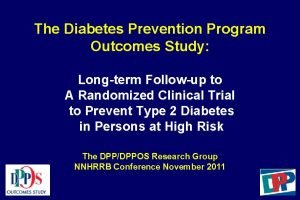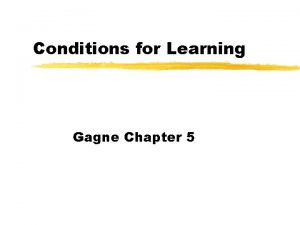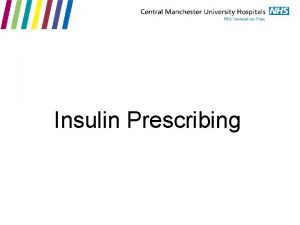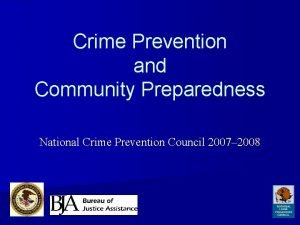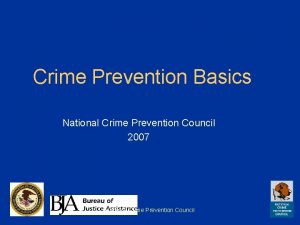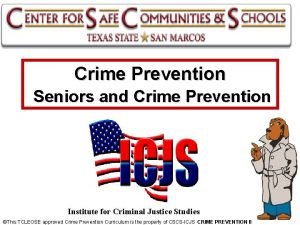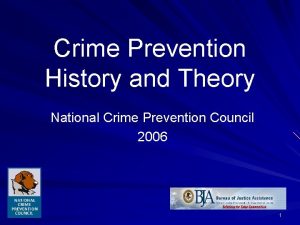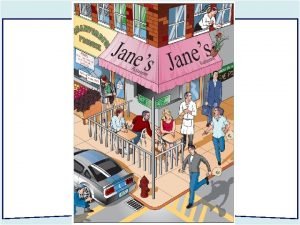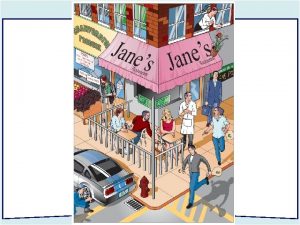Crime Prevention Introduction to Crime Prevention Learning outcomes































- Slides: 31

Crime Prevention

Introduction to Crime Prevention • Learning outcomes: 1. 2. 3. 4. 5. Understand the definition of crime prevention used by the United Nations Distinguish between key terms used in crime prevention and community safety contexts Describe different crime prevention typologies Apply different crime problem-solving approaches to common crime problems Critically analyse ‘what works’ in crime prevention (including what constitutes evidence and the transferability of this evidence) and identify relevant clearinghouses of such information

Exercise: What is crime prevention? • • • A home visit by an early health nurse to all new parents is provided to check on how they are managing the demands of parenthood. Is this a crime prevention measure? A landscape architect makes a number of recommendations in relation to the development of a new housing estate. Some of these recommendations include the planting of low growing vegetation at the front of all homes and the installation of a garden bed along the front of the fences. Is this a crime prevention measure? The diagrams below show an anti-theft device that fits beneath tables in bars. Is this a crime prevention measure? Source: http: //www. designagainstcrime. com/projects/grippa-clips/ • • • Machine-readable microchips will be implanted under the skin of thousands of offenders as part of an expansion of an electronic tagging scheme. Tiny chips would be surgically inserted under the skin of offenders in the community, to help enforce home curfews. The radio frequency identification (RFID) tags, as long as two grains of rice, are able to carry scanable personal information about individuals, including their identities, address and offending record. Is this a crime prevention measure? Mandatory drug testing has been introduced in some workplaces, especially where the performance of intricate physical tasks is required. Is this a crime prevention measure? The work of security personnel responsible for the management of cash-in-transit (i. e. large collection and distribution of cash to businesses) is governed by work safety guidelines. These guidelines seek to protect security personnel involved in cash-in-transit activities. Is this a crime prevention measure?

Definition The Prevention of Crime comprises: “strategies and measures that seek to reduce the risk of crimes occurring, and their potential harmful effects on individuals and society, including fear of crime, by intervening to influence their multiple causes” (https: //www. unodc. org/pdf/criminal_justice/Handbook_on_Crime_Prevention_Guidelines__Making_them_work. pdf)

Terminology P e m i r C n o i t n e v re y t i n u m m o C Crime R eductio y t e f a S n l o r t n o C e m i r C

Terminology Term Definition Community “Community safety is realized through an integrated consideration of diverse harms to the public, and ‘refers to Safety the likely absence of harms from all sources, not just from human acts classifiable as crimes’ (Wiles and Pease, 2000). Community safety also provides a strategic viewpoint on community harms by focusing attention towards the development of programmes that set targets to manage risks and aims to maximise public safety” (2005: 1718) Crime prevention involves any activity by an individual or group, public or private, which attempts to eliminate Prevention crime prior to it occurring or before any additional activity results. By drawing on the public health model, some theorists have distinguished between primary crime prevention (universal), secondary crime prevention (at-risk) and tertiary crime prevention (known offenders). Crime “Crime reduction is concerned with diminishing the number of criminal events and the consequences of crime. Reduction Crime reduction is applied within the bandwidth of an available resource input (e. g. financial input) and needs to be considered as an action that brings net benefits, fear of crime and the impact of other programmes that may have contributed to any specific crime reduction activity. Crime reduction promotes a spirit of optimism that actions towards a problem will reduce crime or reduce the seriousness of criminal events … it aims to intervene directly in the events and their causes” (2005: 19). Crime “Crime control considers that crime has already happened and that some management of these criminal Control activities is required to ensure that it does not spiral out of control. It points to the need for maintenance of a problem, one where crime is kept to a tolerable level, and not to a situation where crime can be prevented” (2005: 18 -19). Source: Chainey, S. and Ratcliffe, J. (2005) GIS and crime mapping, Wiley and Sons, Chester.

Models of Prevention “Primary crime prevention identifies conditions of the physical and social environment that provide opportunities for or precipitate criminal acts. Here the objective of intervention is to alter those conditions so that crimes cannot occur. Secondary crime prevention engages in early identification of potential offenders and seeks to intervene in their lives in such a way that they never commit criminal violation. Tertiary crime prevention deals with actual offenders and involves intervention in their lives in such a fashion that they will not commit further offenses” (Brantingham, P. J. and Faust, F. L. (1976) ‘A conceptual model of crime prevention’, Crime and Delinquency, vol. 22, no. 3: 290).

Models of Prevention The typology proposed by Tonry and Farrington is frequently used and includes four major prevention strategies: “law enforcement, and developmental, community, and situational prevention” (Tonry, M. and Farrington, D. (1995) ‘Preface’, in Tonry, M. and Farrington, D. (eds) Building a Safer Society: Strategies Approaches to Crime Prevention, Crime and Justice: A Review of Research, Volume 19, The University of Chicago Press, Chicago and London: 1 -2).

Model Explanation Developmental Often known as early intervention, developmental crime prevention seeks to address the early causes of criminality. Reducing community and individual risk factors and increasing protective factors, help to prevent crime later in life. Community / Strengthening neighbourhoods helps prevent Social crime. Local communities that have strong bonds and where people know each other are generally less prone to experience crime. Enhancing ‘social capital’ or the relationships between people can be beneficial in protecting people from crime. Situational Stopping the opportunities for crime is an effective way of preventing crime. Increasing the risks of detection, reducing the rewards for offending and increasing the difficulty of offending are all ways to prevent crime. Law This form of crime prevention is associated with Enforcement / the criminal justice system - police, courts and Criminal prisons – and is the most commonly understood Justice form of crime prevention. Examples The most celebrated examples of developmental crime prevention include parenting programs, school enrichment initiatives like skills training, pre-school regimes and improvements in transition to school arrangements. Community building activities, provision of welfare services and increasing community support groups all help to enhance the sense of community and can contribution to the prevention of crime. Situational crime prevention can be as simple as installing locks and alarms, increasing surveillance through lighting and making buildings harder to enter, damage or hide near. Problem-oriented policing can help prevent recurring problems requiring a policing response through detailed analysis of crime problems and inter-agency responses; community-oriented policing is a strategy for encouraging the public to act as partners with the police in preventing and managing crime; treatment programs offered through court processes can address causes of crime; rehabilitation programs in prison can prevent re-offending.

Developmental Crime Prevention ‘Developmental prevention involves the use of scientific research to guide the provision of resources for individuals, families, schools or communities to address the conditions that give rise to antisocial behaviour and crime before these problems arise, or before they become entrenched … Doing something about crime early, preferably before the damage is too hard to repair, strikes most people as a logical approach to crime prevention. The twin challenges, of course, are to identify exactly what it is in individuals, families, schools and communities that increases the odds of involvement in crime and then to do something useful about the identified conditions as early as possible’ (Homel, R. and Thomsen, L. (2017) Chapter 4: ‘Developmental Crime Prevention’, in Tilley, N. and Sidebottom, A. (eds. ) Handbook of Crime Prevention and Community Safety, Willan Publishing, Devon: 57).

Risk Factors • Risk is cumulative and risk factors are inter-related (not easy to isolate causal link) • The most significant risk factors associated with offending: Individual Risk Factors Low intelligence and attainment Family Risk Factors Criminal or antisocial parents Environmental Risk Factors Growing up in a low SES status household Personality and temperament Large family size Associating with delinquent peers Empathy and impulsiveness Poor parental supervision Attending high-delinquencyrate schools Parental conflict and disrupted families Living in deprived areas (Farrington, D. and Welsh, B. (2007) Saving Children From a Life of Crime, Oxford University Press, Oxford: 159)

Case Study: Elmira Home Visiting Program • The seminal Elmira prenatal and infancy home visiting program provided support to 400 young mothers who were single or from low socioeconomic backgrounds in the city of Elmira, New York. It intended to address issues of poor birth outcomes, child maltreatment, welfare dependence and poor maternal life courses. Nurses visited young mothers on a bi-weekly basis until their child reached the age of two. The home visitation sessions were focused on providing prenatal care, baby health care and support to keep the young mothers’ lives on track, through helping them find employment, planning for the future or linking them up with much needed services within the community. • Very positive outcomes emerged from the Elmira home visitation program. Participants in the home visitation program exhibited the following outcomes in comparison the control group (Olds et al, 1999 p. 44): improved pregnancy outcomes; better parenting skills; higher maternal employment; fewer and more widely spaced pregnancies; more mothers returned to education; less abuse and/or neglect the children; less smoking and drinking; and by the time the children were at 15 years of age, fewer arrests and convictions (both mother and child). • The home visitation program was also successful in delivering considerable cost savings for the government. Every $1 USD spent on the home visitation program resulted in future savings of $4 USD (Olds et al, 1999, p. 56). • Olds, David L. , Henderson, Charles R. , Kitzman, Harriet J. , Eckenrode, John J. , Cole, Robert E. and Tatelbaum, Robert C. (1999) “Prenatal and infancy home visitation by nurses: recent findings. ” Future Child vol. 9, no. 1. • Olds, David L. (2002) “Prenatal and Infancy Home Visiting by Nurses: From Randomized Trials to Community Replication. ” Prevention Science vol. 3, no. 3.

Community Crime Prevention • “Community crime prevention refers to actions intended to change the social conditions that are believed to sustain crime in residential communities. It concentrates on the ability of local social institutions to reduce crime” (Hope, T. (1995) ‘Community crime prevention’, in M Tonry & D Farrington (eds. ) Building a safer community: strategic approaches to crime prevention, The University of Chicago Press, Chicago: 21) • Generally speaking, high levels of informal social control and collective efficacy in local communities result in lower crime. The following provides an insight into the nature of these constructs: ►“Sampson and his coauthors then introduced the term ‘collective efficacy’, which is defined in terms of the neighbourhood’s ability to maintain order in public spaces such as streets, sidewalks, and parks. Collective efficacy is implemented when neighbourhood residents take over actions to maintain public order, such as by complaining to the authorities or by organizing neighbourhood watch programs. The authors argued that residents take such actions only when ‘cohesion and mutual trust’ in the neighbourhood is linked to ‘shared expectations for intervening in support of neighbourhood social control’. If either the mutual trust or the shared expectations are absent, then residents will be unlikely to act when disorder invades public space” (Vold et al, 2002, Theoretical Criminology, pages 131 -132)

Case Study: Communities that Care • • • Communities That Care (CTC) is a community-based prevention system. CTC aims to promote the healthy development of children and young people through long term community planning to prevent health and social problems. CTC guides communities towards identifying and understanding local needs, setting priorities and implementing effective evidence-based interventions to address those needs. The CTC model has been implemented in numerous countries around the world and is currently operating in over 500 communities. CTC is founded upon the ‘Social Development Strategy’, it is a strategy that promotes positive youth development by organising the all the evidence-based protective factors into a simple strategy for action. It comprises of the following five key components (CTC, 2018): ► Healthy beliefs and clear standards of behaviour – young people are more likely to engage in prosocial and responsible behaviour when they are surrounded by teachers, parents and a community that communicates healthy beliefs and standards ► Bonding – young people need to develop and maintain strong relationships with those who hold healthy beliefs and clear standards ► Opportunities – developmentally appropriate opportunities should be provided to young people, for active participation and meaningful interaction with prosocial others ► Skills – young people should be taught the skills they need to succeed in life ► Recognition – consistent, specific praise and recognition should be provided to young people for effort, improvement and achievement • Results reported eight years after implementation of the CTC prevention system reveal that: ► Students in CTC communities were more likely than students in control communities to have abstained from any drug use, smoking cigarettes, and engaging in delinquency; and ► They were also less likely to ever have committed a violent act. • More information about CTC and their prevention programs can be found at https: //www. communitiesthatcare. org. au/ or https: //www. communitiesthatcare. net/

Definition - Situational Crime Prevention “Situational prevention comprises opportunity reducing measures that (1) are directed at highly specific forms of crime, (2) involve the management, design or manipulation of the immediate environment in as systematic and permanent way as possible, (3) make crime more difficult and risky, or less rewarding and excusable as judged by a wide range of offenders” (Clarke, R. V. (1997) Situational Crime Prevention – Successful Case Studies, Harrow and Heston, New York: 4).

Elements of a Criminal Act Motivated Offender Suitable Target / Victim Absence of Capable Guardian Felson, M. and Cohen, L. E. (1980) ‘Human Ecology and Crime: A Routine Activity Approach’, Human Ecology, Vol. 8, No. 4: 392.

25 Opportunity-Reducing Techniques Increase the Effort 1. Target Harden Steering column locks Anti-robbery screens Tamper-proof packaging Increase the Risks 6. Extend guardianship Take routine precautions ‘Cocoon’ neighbourhood watch Reduce the Rewards 11. Conceal targets Off-street parking Gender-neutral phone directories Unmarked bullion trucks Reduce Provocations 16. Reduced frustrations and stress Efficient queues and polite service Expanded seating Soothing music/muted lights 12. Remove targets 17. Avoid disputes Removable car radio Separate enclosures for rival Women’s refuges soccer fans Pre-paid phone cards for pay Reduce crowding in pubs phones Fixed cab fares 1. Control access to facilities Entry phones Electronic card access Baggage screening 7. Assist natural surveillance Improved street lighting Defensible space design Support whistleblowers 1. Screen exits Ticket needed for exit Export documents Electronic merchandise tags 8. Reduce anonymity Taxi driver IDs ‘How’s my driving? ’ decals School uniforms 13. Identify property 18. Reduce emotional arousal Property marking Controls on violent pornography Vehicle licensing and parts Enforce good behaviour on marking soccer field Cattle branding Prohibit racial slurs 1. Deflect Offenders 9. Utilise place managers 14. Disrupt markets 19. Neutralise peer pressure Street closures CCTV for double-decker buses Monitor pawn shops ‘Idiots drink and drive’ Separate bathrooms for women Two clerks for convenience stores Controls on classified ads ‘It’s OK to say no’ Disperse pubs Reward vigilance License street vendors Disperse troublemakers at school 23. Alert conscience Roadside speed display boards Signatures for customs declarations ‘Shoplifting is stealing’ 24. Assist compliance Easy library check-out Public lavatories Litter bins 1. Control tools/weapons ‘Smart’ guns Disabling stolen mobile phones Restrict spray paint to juveniles 10. Strengthen formal surveillance Red light cameras Burglar alarms Security guards 25. Control drugs and alcohol Breathalysers in pubs Server intervention Alcohol-free events 15. Deny benefits Ink merchandise tags Graffiti cleaning Speed humps 20. Discourage imitation Rapid repair of vandalism V-chips in TVs Censor details of modus operandi Cornish, D. B. and Clarke, R. V. (2003) ‘Opportunities, precipitators and criminal decisions: A reply to Wortley’s critique of situational crime prevention’, in Smith, M. and Cornish, D. B. (eds) Theory for Situational Crime Prevention, Crime Prevention Studies, Vol. 16, Criminal Justice Press, Monsey, New York. Remove the Excuses 21. Set rules Rental agreements Harassment codes Hotel registrations 22. Post instructions ‘No parking’ ‘Private property’ ‘Extinguish camp fires’

Examples of Situational Crime Prevention Car Locking Devices and Immobilisers Electronic Article Surveillance Source: https: //www. watcherprotect. com/electronic-article-surveillance-eas / Bank Counter Screens Source: http: //www. architecturalarmour. com/security-sectors/bank-counters-security-desks Source: https: //www. confused. com/car-insurance/guides/car-engine-immobilisers-alarms-trackers Airport Security Source: https: //www. thedailymeal. com/travel/things-you-didn-t-know-you-could-bring-through-airport-security-slidesh

Crime Prevention Through Environmental Design (CPTED) • “the physical environment can be manipulated to produce behavioural effects that will reduce the incidence and fear of crime, thereby improving the quality of life” (Crowe, T. (2000) Crime prevention through environmental design: applications of architectural design and space management concepts, 2 nd edn, Butterworth-Heinemann, Boston: 34 -35). • http: //www. securedbydesign. com/industry-advice-and-guides/interactive-design-guide/

Law Enforcement / Criminal Justice Crime Prevention “deals with offending after it has happened, and involves intervention in the lives of known offenders in such a fashion that they will not commit further offences. In so far as it is preventative, it operates through incapacitation and individual deterrence, and perhaps offers the opportunity of treatment in prisons or through other sentencing options (Cameron, M. and Laycock, G. (2002) ‘Crime prevention in Australia’, in Graycar, A. and Grabosky, P. (eds. ) The Cambridge handbook of Australian criminology, Cambridge University Press, Port Melbourne, Australia: 314).

Policing for Prevention Community-based Policing Problem-oriented Policing Pulling Levers or Focused Deterrence Policing This approach recognises that police This approach, developed by Professor David are of the people and for the people. Herman Goldstein, seeks to ensure a Kennedy and his colleagues, seeks to prevent Without community support police are more responsive policing. Rather than crime through detailed analysis of pressing not very effective because a just responding to calls for service, crime problems, communicating with high risk considerable amount of crime is Goldstein suggested that problems offenders, providing swift policing resources if cleared as a result of reports from should be defined with much greater these high risk offenders continue to offend community members. Communityspecificity; that effort needed to be while also extending opportunities to exit crime based policing favours tactics which invested in researching the problem; that through engaging with relevant support services connect the police to local communities. alternative solutions should be and mobilising local community voices to This might be through police considered (including physical technical condemn ongoing criminal (especially violent) involvement in community events; the changes, changes in the provision of activity. This approach relies and coordination of creation of police-community government services, developing new various services, including police, probation and committees to establish local policing community resources, increased use of parole, prosecutors, welfare services, youth priorities; the creation of communitycity ordinances, and improved use of workers, local community members impacted by based roles to help the police connect zoning); and that implementation should crime, and other agencies. Its effectiveness with hard-to-reach groups such as be carefully managed (Goldstein 1979, rests on the swift delivery of a policing and those from minority communities. pp. 244– 58). This approach utilizes the criminal justice response if offending persists SARA model. and the opportunities to exit offending.

Crime Problem-Solving Approaches https: //youtu. be/87 Ne-Qic 5 r 4

23 SARA Model Source: http: //www. popcenter. org/learning/60 steps/index. cfm? page=Welcome

24 Ekblom’s 5 Is http: //www. designagainstcrime. com/files/crimeframeworks/04_5 i_framework. pdf

Crime Problem-solving Exercise • Crime problem: There has been a significant increase in the number of burglaries in the local neighbourhood in the last six months. This is causing concern in the community and residents want action. • Prompts: ► What data will be needed to analyse the problem in fine detail? ► How would you decide what should be done to respond? ► What steps might need to be considered in developing a response to this problem? ► What agencies and individuals might usefully be involved? ► How would you determine the impact, remembering to consider both process and impact evaluation issues?

Campbell Collaboration • The Campbell Collaboration was established in 2000 to address the gaps in knowledge base by drawing together the evaluations that have been conducted into particular crime prevention activities. This is achieved by systematic reviews. • Systematic reviews summarise and evaluate the best available research on specific programmes and interventions (Campbell Collaboration, 2018). The results from multiple high-quality studies are synthesised to produce the best possible evidence. Great importance is placed upon the integrity of the process in which systematic reviews are produced from. • The Crime and Justice coordinating group has published 43 systematic reviews in the Campbell Collaboration library as of August 2018. Plain language summaries (PLS) accompany 18 of the 43 reviews. And 37 of the 43 reviews are related to crime prevention interventions. • http: //www. campbellcollaboration. org/

Exercise: Analyse a Campbell Collaboration Review Police-initiated diversion for youth to prevent future delinquent behaviour Authors: David B. Wilson, Iain Brennan, Ajima Olaghere Published Date: 1 June 2018 URL: https: //campbellcollaboration. org/library/police-initiated-diversion-to-preventfuture-delinquent-behaviour. html Plain Language Summary: Available Conclusions: The authors support the use of police-led diversion as an appropriate response to address youth crime, especially in response to first time young offenders. Read the Plain Language Summary and discuss how this might be used by policymakers.

EMMIE Effect Impact on crime Whether the evidence suggests the intervention led to an increase, decrease or had no impact on crime. Mechanism How it works What is it about the intervention that could explain its effects? Moderators Where it works In what circumstances and contexts is the intervention likely to work/not work? Implementation How to do it What conditions should be considered when implementing an intervention locally? Economic Cost What direct or indirect costs are associated with the intervention and is there evidence of cost benefits? How much it costs Source: http: //whatworks. college. police. uk/toolkit/About-the-Crime-Reduction-Toolkit/Pages/About. aspx

Summary - http: //ses. library. usyd. edu. au/handle/2123/14164 • What are the four models of crime prevention? ► ► • How might criminal justice agencies prevent crime and why might these approaches have limited crime prevention benefits? • What are three elements of the crime triangle? ► ► ► • What changes in our ‘routine activities’ increased opportunities for crime in the latter part of last century? • What is informal social control and what are some examples? • What are the challenges of implementing social crime prevention?

Summary • What are the four models of crime prevention? ► Developmental ► Social (or community) ► Situational ► Criminal justice / law enforcement • How might criminal justice agencies prevent crime and why might these approaches have limited crime prevention benefits? Incapacitation, deterrence, rehabilitation. Always after an offence (or offences) has been committed. • What are three elements of the crime triangle? ► Motivated offender ► Victim or target ► Absence of capable guardianship • What changes in our ‘routine activities’ increased opportunities for crime in the latter part of last century? Suburbanisation, dual income families, increased wealth, weight of consumer items, , , … • What is informal social control and what are some examples? Action taken by residents in response to antisocial behaviour. Graffiti removal and stopping antisocial behaviour. • What are the challenges of implementing social crime prevention? Free-rider effect; imposed; some people/communities will be left out. • What are some early intervention programs? Nurse visitation and child enrichment programs.

More information @Doha. Declaration e 4 j@unodc. org/dohadeclaration unodc. org/e 4 J
 Primary prevention secondary prevention tertiary prevention
Primary prevention secondary prevention tertiary prevention Diabetes prevention program outcomes study
Diabetes prevention program outcomes study In the afylin framework learning outcomes are arranged
In the afylin framework learning outcomes are arranged Water cycle learning outcomes
Water cycle learning outcomes Notice lesson plan
Notice lesson plan Swot analysis objectives
Swot analysis objectives Objective of teaching rhymes
Objective of teaching rhymes Planning goals and learning outcomes
Planning goals and learning outcomes Mesophyll cells
Mesophyll cells Learning objectives of photosynthesis
Learning objectives of photosynthesis Ncbts student learning outcomes
Ncbts student learning outcomes Learning objectives of linear equations in one variable
Learning objectives of linear equations in one variable A machine that converts mechanical energy into electricity
A machine that converts mechanical energy into electricity Learning outcomes of reported speech
Learning outcomes of reported speech Purpose of learning outcomes
Purpose of learning outcomes Input and output devices for visually impaired
Input and output devices for visually impaired Mri ib psychology
Mri ib psychology Essay writing learning outcomes
Essay writing learning outcomes Learning outcomes of holy week
Learning outcomes of holy week What is easter
What is easter Headstart early learning outcomes framework
Headstart early learning outcomes framework Learning outcomes of vegetables
Learning outcomes of vegetables Gagne learning outcomes
Gagne learning outcomes Objectives of arithmetic sequence
Objectives of arithmetic sequence Who does ravi say the kitten's ancestors are?
Who does ravi say the kitten's ancestors are? Learning outcomes of work and energy
Learning outcomes of work and energy Learning objectives of profit and loss
Learning objectives of profit and loss Cooking learning outcomes
Cooking learning outcomes Curriculum and planning ppst reflection
Curriculum and planning ppst reflection Humalog dosage scale
Humalog dosage scale Learning objectives of work and energy
Learning objectives of work and energy Cas learning outcomes
Cas learning outcomes

